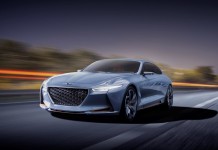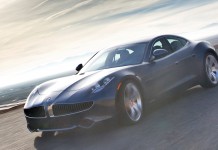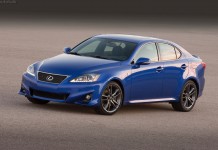The performance luxury car segment is rather difficult to break into. For decades, the Germans have dominated this dual-purpose segment with cars such as the BMW 5-Series, Mercedes-Benz E-Class and Audi A6. As time went on, Japan went after the Germans with the Infiniti M and Lexus GS. These were followed by America’s sporting luxury offerings, the Cadillac CTS and Chrysler 300. The majority of these cars have resulted in a success story and have thus created a crowed and extremely competitive segment. With such strong cars, it came as a shock to the automotive industry when the company known for small but efficient vehicles from Korea, Hyundai, unveiled its attempt in 2009. Since then, the Genesis sedan has worked hard to become a serious competitor and for 2012, Hyundai has upped the ante even more with the Genesis 5.0 R-Spec.
Designed to be able to do many things and do them well, sales of the Genesis Sedan in all its forms have been increasing since its 2009 debut. Hyundai has seen a 33 percent increase in sales year-over-year and in June 2011, the Genesis set an all-time record for its market share. For the 2012 model year, the Korean automaker plans on increasing those sales with their most powerful Genesis rendition yet. To showcase just what the 5.0 R-Spec is capable of, Charleston, South Carolina was chosen as the proving grounds to unleash a plethora of new technologies and features. One particular Genesis, a fully loaded, Black Noir Pearl 5.0 R-Spec, was our weapon of choice to do battle with the city streets and winding passes that make up the coast of South Carolina.
An exceedingly refreshing aspect of the Genesis Sedan model line is the price. So far, there are a total of five trim levels so optioning out a Genesis isn’t a headache. Once you upgrade to one of the eight cylinder models, every option available on the three 3.8 V6 Genesis models becomes standard. The most expensive Genesis, our 5.0 R-Spec sample, can be purchased for $46,500 and that includes every thing offered across the Genesis Sedan model line. That price is fantastic until you look at the base MSRP for a nicely equipped 3.8 model. $34,200 is an absolute crime compared to other competition and undercuts a Mercedes E350 by more than $15,000.


Hyundai is clearly a company that listens to what people are saying. Proof can be found in the 2012 Genesis’s outward aesthetics as the 2009 launch car received a few grips for being a bit too bland looking. The revised front bumper gives the once soft front an injection of aggression and seems to have widened the car’s stance. Lower side skirts also blend well into the reworked rear bumper with new, wide integrated exhaust tips. Keeping up with the trends, Hyundai has also added LED headlamp accents i.e. Audi. Unlike Audi, the Genesis carries its LED treatment in a much less gaudy fashion. And if equipped as the new R-Spec model, new 19 inch multi-spoke wheels fill out the fender wells just right. It may still be more conservative than the art-deco Infiniti M, but the Genesis Sedan, especially in R-Spec mode, now looks the part.
Upgrades to the 2012 Genesis go beyond a handsome set of new clothes. Open the hood of all Genesis trim levels and something new can be found. Gasoline Direct Injection (GDI) can now be found on all engines and helps the base 3.8 liter DOHC V6 make an impressive 333 horsepower. The 3.8 may take the majority of Genesis Sedan sales, but to be truly competitive in the performance luxury segment, a little more ‘oomph’ is required. Hyundai has come to this conclusion as they have built their most powerful production engine yet. Built entirely in-house by Hyundai, the new 5.0 liter (5,038 cc) DOHC, naturally aspirated V8 makes a thoroughly impressive 429 horsepower and 376 lb-ft of torque. Using direct injection and variable valve timing, the new 5.0 makes its power the old-fashion way: breathing nothing but air. It is refreshing to see a naturally aspirated engine being used in a segment mostly dominated by turbochargers and superchargers. Not only does this result in a reduction in weight and breakable components, but the 5.0 in the R-Spec produces the throttle response that can only be found in a naturally aspirated engine.



Driving the R-Spec, it is clear that Hyundai put a lot of engineering into its new powerplant. With a single push of the engine start button, the new V8 growls into life. This is where the R-Spec manages to do something that not too many performance luxury offerings can do: not make itself overly known. The turbocharged unit found in high-output BMWs simply makes too much noise and even the V8 found in the Jaguar XF and XJ makes more racing sounds than wanted out of a luxury car. And unlike the engines found in Lexus models, the R-Spec never sounds boring. The noise produced by the 5.0 is the perfect level for a performance luxury brand; it isn’t too loud or too quiet and blends perfectly with the R-Spec’s personality.
Building thrust is another 5.0 strong suit. Over 300 lb-ft of torque is available at just 1,500 rpm and horsepower builds increasingly up to the 6,400 rpm redline. The Genesis 5.0 R-Spec will never have an issue of merging onto the freeway and will perform 60 mph in just a hair over 5 seconds. Acceleration is not abusive either and this is what makes the R-Spec really special. It builds forcefully, giving a driver that feeling that the increase in speed simply won’t stop. This is even more pronounced when seated in the back, where full throttle acceleration runs felt eerily similar to fight take off. The R-Spec can do adolescent things, but does them in a mature manner.
That maturity can also be attributed to the new eight speed automatic transmission. Built completely in-house by Hyundai (unlike the older ZF derived unit), the eight speed earned 130 patented technology innovations during its development and is now found across the Genesis Sedan model line. Upshifts were practically unnoticeable, even in manual mode. The only time the R-Spec’s transmission made itself known was when coming out of ‘ECO’ mode for full throttle downshifts. And even then, they were never jarring. On the highway, the extra gear ratios will allow the Genesis 5.0 R-Spec to achieve 25 mpg. This transmission works well with the 5.0 engine and despite it having “too many” gears, it doesn’t suffer from gear-hunting like other eight speeds on the market.
To make sure the 5.0 R-Spec can compete with the heavy hitters from Germany, Hyundai revamped the suspension tuning. A large, 19mm rear sway bar, higher spring rates all around and higher damping rated shocks differentiate the R-Spec from other Genesis models. It is a fine handling car as body roll is almost nonexistent and turn in is crisp and informative. Steering feel is weighted just right and doesn’t feel ‘strange’ like the electric units found in BMWs. This isn’t an autocross king, but the Genesis 5.0 R-Spec can easily put a smile on a drivers face when a long road turns into big sweepers.
For $46,500, a Genesis 5.0 R-Spec is truly impressive. The rear seating area isn’t as gadget-packed as other competitors, but it is remarkably comfortable. Cushioning is so supple that the back seats will become a place of envy. The media center is clean and easy to use, but lacks the aesthetic appeal of the more expensive Germans. And even though the steering wheel is firm and filled with quality, it doesn’t telescope enough to offer the most optimal driving position. These issues seem to melt away however after the R-Spec gets moving. It is a rather charming car and destroys the old notions that Korean cars suffer from poor quality. It may not have the thousands of options found on its competition, but the lack of those unnecessary features helps the Genesis to undercut everything in its class. Add in the new-found performance of the 2012 5.0 R-Spec, and the Genesis Sedan will continue to charm drivers into buying a Korean success story.


















[…] 2012 Hyundai Genesis Sedan 5.0 R-Spec First DriveAutoTalkThe turbocharged unit found in high-output BMWs simply makes too much noise and even the V8 found in the Jaguar XF and XJ makes more racing sounds than wanted out of a luxury car. And unlike the engines found in Lexus models, the R-Spec never sounds …and more » […]
[…] 2012 Hyundai Genesis Sedan 5.0 R-Spec First Drive […]